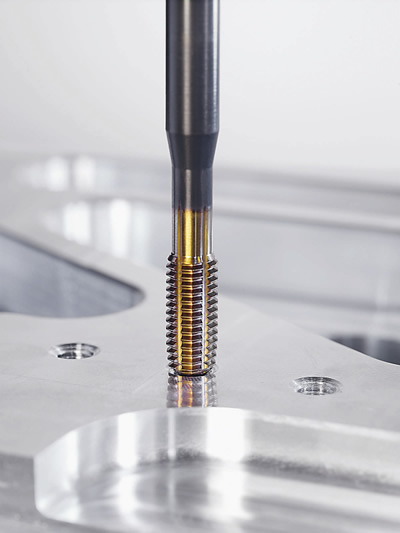Adding internal threads is typically one of the last machining operations performed when manufacturing a part. This means the threading process is critical because a large portion of the manufacturing cost has already been invested in the part. A mistake or scrapped thread could be costly.

Thread forming tools can look similar to taps, but they produce threads in a very different manner. All images courtesy Walter USA.
Therefore, the production rate and tool cost are not always the main focus when it comes to threading. Sometimes process reliability is the most important consideration. One of three threading processes is commonly performed, and they all have advantages for different scenarios.
Tapping
Tapping is the most frequently performed process—estimated at 90 percent—for producing internal threads. The process involves applying a tap tool to cut the workpiece material in the helical configuration required for the threaded hole. The cutting tool must be designed specifically for each thread size and thread style and be fed at a specific feed rate to coincide with thread pitch.
The direction of the feed is only along the Z-axis, which makes programming relatively easy. But, some tool variations should be considered, including number of flutes, chamfer length, tolerance classification, rake angle, clearance angle, flute helix angle and shank standard (the German standards organization DIN or ANSI, for example). Therefore, it can be difficult to find the optimal design for a specific application.
Forming
Thread forming is a process for producing internal threads that has developed quickly over the last 20 years. In this process, the material is pushed, or formed, into the desired shape with a tool that looks similar to a tap, but is completely different in design and functionality. Forming creates a much stronger thread than cutting because it hardens the workpiece by realigning its grain structure while it is in a cold state. In addition, because the workpiece material is not cut, this process produces no chips, eliminating one of the main challenges with tapping—chip control.

Thread mills have a thread form ground into the tool but use the machine toolpath to control size.
However, this also limits the type of material that can be threaded. The material must be ductile. More brittle materials, such as cast iron, should not be thread-formed.
Milling
Thread milling is the process of cutting material with a rotating tool that has a thread form ground into it. The thread mill is smaller than the diameter of the hole to be threaded, and the machine must interpolate the tool while feeding in the Z-axis direction, creating the helical thread shape.
Typically, the tool must travel 360° to machine a complete thread, but some manufacturers recommend a full 180° to enter the cut and another 180° to exit. So, with the latter scenario, the tool would travel two full revolutions to complete the cut.
Milling threads can make programming the machine more complicated, but because the machine partially controls the exact thread size, adjustments can be made to the overall thread size by altering the program. With tapping and thread forming, this type of adjustment is made by purchasing a different tool.
Thread milling is often performed when machining large threads. But uniquely designed thread mills, called orbital thread mills, can machine threads as small as UNC1-64 and are available as standard products. The hole to be milled is 0.0595 " (1.5113mm) in diameter. Taps, however, are available for producing an M1 thread size, which requires a 0.0295 " (0.7493mm) tap drill.
Process Reliability Comparison
Tapping is a reliable and easy way to machine threads. Achieving consistency, however, requires selecting the correct tap for the job.
Controlling chips is the biggest challenge, particularly in blind-holes. To control them, users must select the correct tap design. This is why most tap manufacturers offer a large selection of different styles of taps and tap geometries.
Another challenge is removing a tap that breaks in the cut. Because the tap head is threaded into the part, it can be difficult to remove the broken piece or pieces. This may require additional machining or even moving the part to a different machine, such as a wire EDM, to extract the broken piece or pieces.
There is less variation among thread formers than cutting taps, which must control chips. Compared to taps, thread formers also have a much larger core diameter, which strengthens the tool.
In the event of a broken tool, a thread former is equally difficult to remove from a hole as a tap, but it is much less likely to break in the first place because of the larger core diameter. However, the range of applications and types of materials and sizes of threads that can be formed is much more limited compared to tapping. Some part designers, and even entire industries, include callouts on their manufacturing prints that prohibit thread forming a part.
This is because thread forming leaves a small gap at the tip of the thread form, sometimes called a “fish mouth” for the way it looks. For example, the medical and food industries do not allow thread forming because this small space can be an area where bacteria grow and is not easily cleaned or sterilized. However, the gap has no impact on thread quality.
Thread milling is the most versatile of the three processes. Only the shape and pitch of the thread is built into the tool, so a thread mill can cut any thread size—as long as the style and pitch is the same. For example, the same tool can mill a 1 "-8-dia. and a 1½ "-8-dia. UN-style thread. Small adjustments can be made to the thread size as well to ensure a certain tolerance specification is met or to compensate for tool wear to maximize tool life.
While the core diameter of a thread mill is smaller than a tap or thread former, the thread milling process does not require a tool with as much strength. With the tool diameter being approximately 70 to 80 percent of the thread diameter, the tool engages much less of the part and less torque is exerted on the tool itself. However, in the event of a broken tool, the smaller diameter also allows the tool to easily be extracted from the part, and the machining process can continue after installing a new thread mill.
Due to the preponderance of threads being tapped, tapping can be considered the reference standard regarding process reliability. Compared to tapping, thread forming is considered to have slightly higher process reliability because it does not produce chips. In addition, a thread former has an inherently larger tool body than a tap, so it is far less likely to break during use. So, for maximum process reliability, consider thread milling. CTE

Taps require the correct design for the application to effectively control chips.
Field application I
Recently, Walter USA worked with a die manufacturer in northern Wisconsin to determine if thread milling was a better option than its current tapping method. The tapping process was inconsistent, with erratic tool fracturing and uneven tool life. The P-20 tool-steel part, with a hardness from 33 to 36 HRC, required 30 M30-thread holes with a full thread depth of 2 " (50.8mm). The tap cutting speed was 25 sfm (7.62 m/min.) at 80 rpm, which required 26 seconds to machine the thread.
After some setup and testing, a thread mill matched the cutting time of the tap. Through continued testing, the thread mill achieved a cutting speed of 650 sfm (198.12 m/min.), which reduced the threadmaking time to 19 seconds. Tool life of the thread mill also proved to match that of the tap at 200 pieces, even before compensating for tool wear. Ultimately, the customer was able to machine the part faster at a lower cost per hole and with more consistency and process reliability by switching to thread milling.

Thread formers have a large core diameter, creating a stronger tool than a tap.
Field application II
A fabrication shop in central Illinois was having trouble threading M-8 steel. The print called for a blind-hole to be tapped 17.5mm (0.689 ") deep and through a cross-hole in 17-22 AS cast steel, with a hardness of 35 to 38 HRC. This created chip control issues and sometimes caused a tool to break because the chips were not being properly evacuated.
Walter USA recommended switching from tapping to thread forming. Because the customer was hesitant to change the process, Walter took some sample pieces back to its Technology Center in Waukesha, Wis., to compare tapping and thread forming the feature.
The test results were fairly conclusive; the only hesitation is that it was not possible to run either tool for its full life because only a few sample parts were provided to prove out part quality and process reliability. Testing various tap designs showed some improve- ments. Chip control was enhanced by producing short chips that did not nest together. However, some chips remained in the hole, which then had to be removed via a secondary machining operation. Obviously, no such problem arises when thread forming because the process forms the thread instead of cutting it.
In addition, the thread forming tool showed significantly less wear, giving confidence that, ultimately, tool life would be significantly longer compared to the tap.
The final benefit was the production rate. The tapping feed rate was 10.4 ipm (264.2 mm/min.) while the thread forming feed rate was 23 ipm (584.2 mm/min.). By doubling the feed, thread forming cut the cycle time more than 50 percent. Not only did the customer enhance process reliability with thread forming, but tool life and productivity improved.
Related Glossary Terms
- blind-hole
blind-hole
Hole or cavity cut in a solid shape that does not connect with other holes or exit through the workpiece.
- clearance
clearance
Space provided behind a tool’s land or relief to prevent rubbing and subsequent premature deterioration of the tool. See land; relief.
- cutting speed
cutting speed
Tangential velocity on the surface of the tool or workpiece at the cutting interface. The formula for cutting speed (sfm) is tool diameter 5 0.26 5 spindle speed (rpm). The formula for feed per tooth (fpt) is table feed (ipm)/number of flutes/spindle speed (rpm). The formula for spindle speed (rpm) is cutting speed (sfm) 5 3.82/tool diameter. The formula for table feed (ipm) is feed per tooth (ftp) 5 number of tool flutes 5 spindle speed (rpm).
- electrical-discharge machining ( EDM)
electrical-discharge machining ( EDM)
Process that vaporizes conductive materials by controlled application of pulsed electrical current that flows between a workpiece and electrode (tool) in a dielectric fluid. Permits machining shapes to tight accuracies without the internal stresses conventional machining often generates. Useful in diemaking.
- feed
feed
Rate of change of position of the tool as a whole, relative to the workpiece while cutting.
- flutes
flutes
Grooves and spaces in the body of a tool that permit chip removal from, and cutting-fluid application to, the point of cut.
- gang cutting ( milling)
gang cutting ( milling)
Machining with several cutters mounted on a single arbor, generally for simultaneous cutting.
- hardness
hardness
Hardness is a measure of the resistance of a material to surface indentation or abrasion. There is no absolute scale for hardness. In order to express hardness quantitatively, each type of test has its own scale, which defines hardness. Indentation hardness obtained through static methods is measured by Brinell, Rockwell, Vickers and Knoop tests. Hardness without indentation is measured by a dynamic method, known as the Scleroscope test.
- helix angle
helix angle
Angle that the tool’s leading edge makes with the plane of its centerline.
- inches per minute ( ipm)
inches per minute ( ipm)
Value that refers to how far the workpiece or cutter advances linearly in 1 minute, defined as: ipm = ipt 5 number of effective teeth 5 rpm. Also known as the table feed or machine feed.
- milling
milling
Machining operation in which metal or other material is removed by applying power to a rotating cutter. In vertical milling, the cutting tool is mounted vertically on the spindle. In horizontal milling, the cutting tool is mounted horizontally, either directly on the spindle or on an arbor. Horizontal milling is further broken down into conventional milling, where the cutter rotates opposite the direction of feed, or “up” into the workpiece; and climb milling, where the cutter rotates in the direction of feed, or “down” into the workpiece. Milling operations include plane or surface milling, endmilling, facemilling, angle milling, form milling and profiling.
- milling machine ( mill)
milling machine ( mill)
Runs endmills and arbor-mounted milling cutters. Features include a head with a spindle that drives the cutters; a column, knee and table that provide motion in the three Cartesian axes; and a base that supports the components and houses the cutting-fluid pump and reservoir. The work is mounted on the table and fed into the rotating cutter or endmill to accomplish the milling steps; vertical milling machines also feed endmills into the work by means of a spindle-mounted quill. Models range from small manual machines to big bed-type and duplex mills. All take one of three basic forms: vertical, horizontal or convertible horizontal/vertical. Vertical machines may be knee-type (the table is mounted on a knee that can be elevated) or bed-type (the table is securely supported and only moves horizontally). In general, horizontal machines are bigger and more powerful, while vertical machines are lighter but more versatile and easier to set up and operate.
- pitch
pitch
1. On a saw blade, the number of teeth per inch. 2. In threading, the number of threads per inch.
- rake
rake
Angle of inclination between the face of the cutting tool and the workpiece. If the face of the tool lies in a plane through the axis of the workpiece, the tool is said to have a neutral, or zero, rake. If the inclination of the tool face makes the cutting edge more acute than when the rake angle is zero, the rake is positive. If the inclination of the tool face makes the cutting edge less acute or more blunt than when the rake angle is zero, the rake is negative.
- shank
shank
Main body of a tool; the portion of a drill or similar end-held tool that fits into a collet, chuck or similar mounting device.
- tap
tap
Cylindrical tool that cuts internal threads and has flutes to remove chips and carry tapping fluid to the point of cut. Normally used on a drill press or tapping machine but also may be operated manually. See tapping.
- tapping
tapping
Machining operation in which a tap, with teeth on its periphery, cuts internal threads in a predrilled hole having a smaller diameter than the tap diameter. Threads are formed by a combined rotary and axial-relative motion between tap and workpiece. See tap.
- threading
threading
Process of both external (e.g., thread milling) and internal (e.g., tapping, thread milling) cutting, turning and rolling of threads into particular material. Standardized specifications are available to determine the desired results of the threading process. Numerous thread-series designations are written for specific applications. Threading often is performed on a lathe. Specifications such as thread height are critical in determining the strength of the threads. The material used is taken into consideration in determining the expected results of any particular application for that threaded piece. In external threading, a calculated depth is required as well as a particular angle to the cut. To perform internal threading, the exact diameter to bore the hole is critical before threading. The threads are distinguished from one another by the amount of tolerance and/or allowance that is specified. See turning.
- tolerance
tolerance
Minimum and maximum amount a workpiece dimension is allowed to vary from a set standard and still be acceptable.
- toolpath( cutter path)
toolpath( cutter path)
2-D or 3-D path generated by program code or a CAM system and followed by tool when machining a part.
- wire EDM
wire EDM
Process similar to ram electrical-discharge machining except a small-diameter copper or brass wire is used as a traveling electrode. Usually used in conjunction with a CNC and only works when a part is to be cut completely through. A common analogy is wire electrical-discharge machining is like an ultraprecise, electrical, contour-sawing operation.



